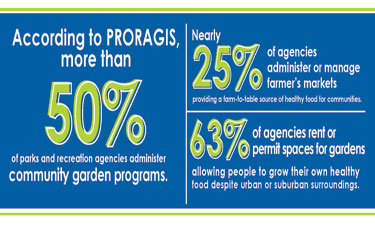 As America grapples with high obesity rates, easy access to fresh, reasonably priced and wholesome foods has become an increasingly important strategy in addressing this problem. Data from PRORAGIS tells us that park and recreation agencies are key providers of two tools to fight this “battle of the bulge” in many communities, while also highlighting issues of social equity that many cities struggle to address. For many Americans, access to sources of quality food is far from a given. More than 23.5 million Americans, including 6.5 million children, live in low-income areas more than 1 mile from a supermarket.1 Low-income areas are half as likely to contain a supermarket when compared to wealthy areas, and only 8 percent of African-Americans live in Census tracts containing grocery stores versus 31 percent of white Americans.2
As America grapples with high obesity rates, easy access to fresh, reasonably priced and wholesome foods has become an increasingly important strategy in addressing this problem. Data from PRORAGIS tells us that park and recreation agencies are key providers of two tools to fight this “battle of the bulge” in many communities, while also highlighting issues of social equity that many cities struggle to address. For many Americans, access to sources of quality food is far from a given. More than 23.5 million Americans, including 6.5 million children, live in low-income areas more than 1 mile from a supermarket.1 Low-income areas are half as likely to contain a supermarket when compared to wealthy areas, and only 8 percent of African-Americans live in Census tracts containing grocery stores versus 31 percent of white Americans.2
Community gardens at park and recreation sites are gaining popularity because of the tangible and intangible value they provide to local communities. In fact, PRORAGIS tells us that more than 50 percent of responding agencies offer community garden programs. Not only do these programs improve the quality of life for gardeners through the production of nutritious food, they are a catalyst for neighborhood and community development, stimulate social interaction, reduce family food budgets, conserve resources, create opportunities for recreation, exercise and education, preserve green space and provide opportunities for intergenerational and cross-cultural relationships.3 Community gardens at park and recreation sites are particularly important for children in increasing their knowledge and health through gardening programs. Such opportunities increase awareness of food origin and proper nutrition and allow participants to acquire hands-on skills and intergenerational connections.2
Park and recreation agencies provide farmers’ markets in the communities of almost one quarter of PRORAGIS participants.4 Not only are they qualified to assist in the development and organizational tasks required to start a farmers’ market, they are also experts in incorporating recreational programming as an important part of the farmers’ market experience. Recreational events at farmers’ markets strengthen community bonds and play a significant role in attracting consumers to markets.5 In many cities, farmers’ markets may provide some citizens their only access to “farm-to-table” produce and possibly their only access to produce of any type.
Once again, the data from PRORAGIS tells us what park advocates have long known — our professionals and their agencies manage and perform important services for their citizens that range far outside of the traditional perception of what a park and recreation agency provides.
Travis Smith, Ph.D., is NRPA’s Vice President of Research. Rishma Parpia is a Research Consultant at The Research Workroom LLC.
References
1) USDA Economic Research Service Report Summary, June 2009.
2) Morland et al. “The Contextual Effect of the Local Food Environment on Residents’ Diets,” American Journal of Public Health. November 2002, Vol. 92, No. 11
3) The National Recreation and Park Association. 2011. Community Gardens in Parks:Opportunities for Health, Community and Recreation. Retrieved on August 8, 2014
4) The National Recreation and Park Association. 2011. Community Gardens in Parks:Opportunities for Health, Community and Recreation. Retrieved on August 8, 2014
5) The National Recreation and Park Association. n.d. Park Vending and Farmer’s Markets: Increasing Healthy Food Choices for Underserved Communities. Retrieved on August 9, 2014

